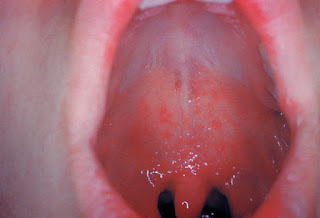Erythromelalgia: A Rare Disorder That is Difficult to Diagnose
Erythromelalgia is a rare, acquired or (very rarely) inherited clinical syndrome of intermittently red, hot, painful extremities. The syndrome usually affects the lower extremities (predominantly the feet) but may also involve the upper extremities (predominantly hands) and rarely concomitantly involves the face. Patients instinctively try to relieve symptoms by cooling the involved areas with fans, cold water, or ice.
There is no cure for erythromelalgia; therefore, treatment is focused on improving symptoms. Many patients can be successfully managed with behavioral interventions, topical medications, and aspirin. Other interventions may be beneficial when these measures are insufficient.
The epidemiology, clinical features, diagnosis, and management of erythromelalgia will be reviewed here.
There is no cure for erythromelalgia; therefore, treatment is focused on improving symptoms. Many patients can be successfully managed with behavioral interventions, topical medications, and aspirin. Other interventions may be beneficial when these measures are insufficient.
The epidemiology, clinical features, diagnosis, and management of erythromelalgia will be reviewed here.
EPIDEMIOLOGY
Epidemiologic data on erythromelalgia is limited, but erythromelalgia appears to be rare. Population-based studies from the United States, Sweden, and Norway have found incidence rates of less than 2 per 100,000 people per year.
Erythromelalgia is more common in women than in men and most often occurs in adults. In a population-based study in Olmsted County, Minnesota, the age-adjusted incidence rates were 2 per 100,000 women and 0.6 per 100,000 men. The median age at diagnosis was 61 years (range, 16 to 90 years). Among 27 patients with erythromelalgia identified in a Swedish study, the median age was 49 years (interquartile range 34 to 68 years).
Erythromelalgia is exceedingly rare in children. In the largest series reported of pediatric erythromelalgia, which included 32 patients (including 22 females) evaluated at an academic medical center between 1970 to 2007, the mean age was 14 years (range, 5 to 18 years) and the mean time to diagnosis was 5.2 years.
Erythromelalgia is more common in women than in men and most often occurs in adults. In a population-based study in Olmsted County, Minnesota, the age-adjusted incidence rates were 2 per 100,000 women and 0.6 per 100,000 men. The median age at diagnosis was 61 years (range, 16 to 90 years). Among 27 patients with erythromelalgia identified in a Swedish study, the median age was 49 years (interquartile range 34 to 68 years).
Erythromelalgia is exceedingly rare in children. In the largest series reported of pediatric erythromelalgia, which included 32 patients (including 22 females) evaluated at an academic medical center between 1970 to 2007, the mean age was 14 years (range, 5 to 18 years) and the mean time to diagnosis was 5.2 years.
ASSOCIATED DISEASES
Although originally described in association with myeloproliferative diseases (e.g., essential thrombocytosis, chronic myelogenous leukemia, polycythemia vera, myelofibrosis), erythromelalgia appears to be associated with underlying myeloproliferative diseases in less than 10 percent of cases. A diagnosis of myeloproliferative disease may precede, follow, or coincide with the development of erythromelalgia.
A variety of other comorbidities (e.g., autoimmune diseases, infections, neoplasms, neurologic diseases), pregnancy, and drug exposures have been reported in patients with erythromelalgia in case reports. However, the relationship between erythromelalgia and these diseases is unclear.
A variety of other comorbidities (e.g., autoimmune diseases, infections, neoplasms, neurologic diseases), pregnancy, and drug exposures have been reported in patients with erythromelalgia in case reports. However, the relationship between erythromelalgia and these diseases is unclear.
PATHOGENESIS
The pathogenesis of erythromelalgia is not fully understood. Vascular, neural, and genetic factors may play roles.SIGNS & SYMPTOMS
During episodes, affected areas (typically distal extremities) become red or violaceous, hot, and painful. Swelling occasionally occurs. The episodes are intermittent and generally last for minutes to hours before resolving.
Episodes occur in association with precipitating factors (e.g., increase in ambient heat or exercise) and often occur at night (perhaps associated with increased ambient heat in bed). The number of episodes per day is highly variable.
Erythromelalgia affects the feet (e.g., toes, soles of the feet, dorsum of the feet, or entire feet) in approximately 90 percent of patients. The fingers, dorsal hands, or entire hands are affected in approximately 25 percent. Occasionally, erythromelalgia extends to involve more proximal portions of the extremities. Symptoms are usually symmetrical but may be unilateral or more prominent on one side of the body.
Head and neck involvement (e.g., ears, nose, cheeks) is infrequent, occurring in 2 to 3 percent of patients. Whether painful flushing of the face (e.g., ears, nose, cheeks) alone can be considered to represent erythromelalgia is debated; we favor a diagnosis of erythromelalgia only if feet and/or hands are also involved.
Pain during episodes is most commonly described as a burning sensation. The pain can be extreme and may seem out of proportion to the observed clinical findings.
Between episodes, the characteristic features of redness, heat, and pain in affected body areas are absent. However, in up to two-thirds of patients, the affected areas are cool to the touch and purple in color (acrocyanosis) between episodes. Features of Raynaud phenomenon have also been reported.
Episodes occur in association with precipitating factors (e.g., increase in ambient heat or exercise) and often occur at night (perhaps associated with increased ambient heat in bed). The number of episodes per day is highly variable.
Erythromelalgia affects the feet (e.g., toes, soles of the feet, dorsum of the feet, or entire feet) in approximately 90 percent of patients. The fingers, dorsal hands, or entire hands are affected in approximately 25 percent. Occasionally, erythromelalgia extends to involve more proximal portions of the extremities. Symptoms are usually symmetrical but may be unilateral or more prominent on one side of the body.
Head and neck involvement (e.g., ears, nose, cheeks) is infrequent, occurring in 2 to 3 percent of patients. Whether painful flushing of the face (e.g., ears, nose, cheeks) alone can be considered to represent erythromelalgia is debated; we favor a diagnosis of erythromelalgia only if feet and/or hands are also involved.
Pain during episodes is most commonly described as a burning sensation. The pain can be extreme and may seem out of proportion to the observed clinical findings.
Between episodes, the characteristic features of redness, heat, and pain in affected body areas are absent. However, in up to two-thirds of patients, the affected areas are cool to the touch and purple in color (acrocyanosis) between episodes. Features of Raynaud phenomenon have also been reported.
- Clinical course: Erythromelalgia usually remains intermittent. Some patients report that symptoms become more frequent and prolonged over months to years. Occasionally, episodes of erythromelalgia become continuous.
- Cooling behaviors: A characteristic feature of erythromelalgia is patient use of cooling techniques to achieve symptom relief. In addition to stopping precipitating actions (e.g., stopping exercise, decreasing ambient heat by decreasing room temperature) upon onset of an episode, patients often engage in:
- Use of fans on affected area
- Immersion of the affected area in ice water, snow, or equivalents
- Application of ice packs, bags of frozen vegetables, battery-powered cooling socks or gloves
- Quality of life: Erythromelalgia can have a profound negative effect on quality of life. Patients usually avoid precipitating exposures (e.g., exercise, warm rooms), which in severe cases can result in becoming housebound, anxious, or depressed secondary to fear of precipitating episodes. Patients with severe symptoms may become wheelchair bound or bed bound.
PATHOLOGY
Skin biopsies of affected areas show nonspecific findings. Examples of reported findings include smooth muscle cell hyperplasia and/or swelling in arterioles; thickened, arteriolar basement membranes; mild, perivascular, lymphocytic inflammation; and mild, perivascular edema.
MANAGEMENT
There is no cure for erythromelalgia. Therefore, interventions are directed at improving quality of life and reducing symptoms.- Nonpharmacologic measures: Nonpharmacologic measures should be included in the management of patients with erythromelalgia as they can reduce symptoms and may reduce requirements for pharmacologic therapy. The following interventions can be helpful for alleviating episodes:
- Avoidance of precipitating factors (increased ambient heat, exercise) as much as possible while maintaining as normal a lifestyle as possible
- Exposure of the affected area to cool water for short periods of time (e.g., 5 to 10 minutes every one to two hours)
- Limb elevation
- Fan use for short periods of time (5 to 10 minutes every one to two hours)
- Pharmacologic therapy: A variety of topical and systemic therapies have been used for erythromelalgia. Efficacy data are limited and insufficient for conclusions on the best approach to treatment and best treatment regimens. Comparative trials have not been performed.
- Topical treatments: Case series and retrospective studies suggest that topical lidocaine and compounded amitriptyline and ketamine may improve the pain associated with erythromelalgia. Other topical treatments that have been suggested, but not formally studied. Topical vasoactive medications may be helpful for improving redness, such as compounded midodrine 0.2%.
- Systemic treatments: Systemic therapy also may be beneficial. Aspirin is a common initial treatment that may be particularly useful for patients with myeloproliferative disease based upon data from case reports and case series. Common treatments described as beneficial in case reports are agents used for neuropathic pain, including gabapentin, pregabalin, venlafaxine, and oral amitriptyline. There have been reports of benefit from systemic glucocorticoids in patients with sudden-onset, severe erythromelalgia who were treated within weeks after the onset of symptoms. Rarely, epidural anesthesia or surgical intervention is used for erythromelalgia. Benefit from epidural bupivacaine hydrochloride and thoracic or lumbar sympathectomy is described in case reports.
- Pain rehabilitation programs: In our experience, patients with refractory, debilitating pain may benefit from pain rehabilitation programs. Pain rehabilitation programs use a multidisciplinary and behavioral therapy approach to help restore physical activities and improve the quality of life for patients with chronic pain. In an uncontrolled study of eight patients with incapacitating erythromelalgia who underwent a pain rehabilitation program, scores on all measures of physical and emotional functioning improved.
- Patient counseling: Fear of precipitating episodes of erythromelalgia may prompt patients to dramatically alter their lifestyles to avoid potential triggers for symptoms. Provided pain is adequately controlled, patients should be encouraged to engage in a normal lifestyle as much as possible. There is no data to show that engaging in precipitating activities will worsen the long-term outcome of erythromelalgia. Many patients can tolerate swimming as a form of exercise that may be less likely to precipitate episodes.
Support groups, such as the Erythromelalgia Association, can be a valuable resource for patients.
Comorbidities
People with erythromelalgia are more likely to have other conditions, such as:
- Atrial fibrillation
- Hypertension
- Migraine headaches
- Polycythemia vera
- Sleep apnea
Prognosis
The prognosis for people with erythromelalgia is variable. Some people have mild symptoms that are easily controlled with treatment. Others have more severe symptoms that can be disabling.
Conclusion
Erythromelalgia is a rare neurovascular disorder characterized by painful episodes of erythema and heat in the extremities. Although it presents significant challenges in diagnosis and management, a multidisciplinary approach can help alleviate symptoms and improve patients' quality of life. Ongoing research and collaboration are essential to enhance our understanding of this condition and develop effective therapies for patients with erythromelalgia.
If you think you may have erythromelalgia, it is important to see a doctor for diagnosis and treatment. There is no cure for erythromelalgia, but there are treatments that can help to relieve the symptoms and improve your quality of life.
.jpeg)
.jpeg)
.jpeg)




Comments
Post a Comment